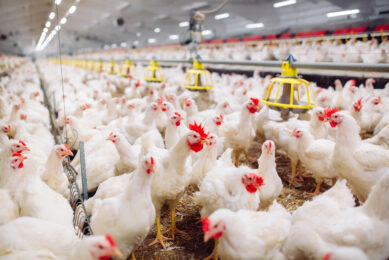A targeted approach with seaweed extracts

Concerns on the emergence of antibiotic resistance calls for innovative technologies as an alternative to antibiotics to support animal health. Seaweed sulfated polysaccharide technology (Olmix MSP) offers targeted support.
Gut health has become increasingly important in the livestock industry with the emergence of antimicrobial resistance and the urge to limit the use of antibiotics. The intestinal mucosa converges various functions: digestion and absorption of nutrients; as well as physical barrier against microbes and toxins thanks to the presence of a protective mucus layer and tight junction proteins that seal the paracellular space. In modern production systems, the gastrointestinal tract is being challenged and the subtle balance gut health relies on can be impaired. The components that define gut barrier and immune function can weaken and lead to higher occurrence of digestive troubles associated with dysbiosis. This disbalance will trigger local and systemic inflammation, affecting the global health status and the growth performance of the animals. The challenge in the industry is to find solutions capable of supporting the epithelial barrier function and the gut-associated lymphoid tissue (GALT) in order to maintain a proper gut health and thus ensure good performance without the need of antibiotics.

Seaweeds: the multi-asset solution
Many candidates are available, with varying efficacy and scientific evidence. Among them, seaweeds, or macroalgae, have gained great interest in the past decades and are the object of increasing research. In literature, seaweeds are being ascribed a wide range of biological activities, such as immunomodulating, antioxidant, antiviral or antihyperlipidemic properties.
Seaweeds are divided into 3 groups:
- brown
- red
- green algae
Despite their phylogenetic differences, seaweeds share the specificity of their parietal polysaccharides, which structural complexity and unique composition make very reactive and explain their biological activities towards animals, plants and humans. The complexity and reactivity of seaweed polysaccharides derive from the nature of the sugar units, which are diverse and sometimes rare, like uronic acids, xylose and rhamnose, the variety of glycosidic bonds leading to their branched structure and the presence of sulfate groups (Figure 1). Furthermore, their polyanionic structure and solubility increases their reactivity and facilitates their recognition by host cells.
Figure 1 – Seaweed polysaccharides structure.

The main types of seaweed polysaccharides are:
- agar and carrageenans (red seaweeds),
- ulvans (green seaweeds)
- fucans (brown seaweeds)
Each of them presenting specific molecular traits which determine their biological properties and reactivity. Therefore, it is important to identify which types of polysaccharides are responsible for a given biological activity in view of extracting them and use them to support gut health. Such work has been at the core of Olmix Group research and development activities for the past 10 years.
Dedicated actions to support gut health
Immune modulation was the first target of Olmix Group, after the use of antibiotics as growth promoters was banned in Europe. A candidate extract from the green algae Ulva sp (MSP Immunity) was identified as an immune modulator. A research project in collaboration with INRA led to the demonstration of its effect on immune mediators in pig and poultry models, including the identification of the metabolic pathways involved in this activation (Figure 2). Berri et al. (2016) first highlighted that MSP Immunity could stimulate the gene expression of several immune mediators (cytokines and chemokines). Among others, the extract showed to upregulate the expression of TNFα, involved in the innate immune response via macrophage activity stimulation, as well as CCL20 and IL-1α, respectively working on the recruitment and differentiation of T and B lymphocytes (adaptive immune response), and PPARγ which has anti-inflammatory properties. In vivo studies further confirmed that MSP Immunity could modulate animal’s immune response, supporting them in critical stages by favouring the transfer of immunity from the sow to its piglets (increased IgG titres in the colostrum and IgA in the milk), or supporting the development of the adaptive immune response in broilers (decreased heterophil to lymphocyte ratio). Using this extract punctually (commercially available as Searup, used in the drinking water), around vaccination or in the event of a viral attack, has shown to boost the immune system and favour an animal’s recovery, while a continuous in-feed use (newly launched Algimun), could strengthen animal’s defences all along their cycle, particularly in early stages when they are the most sensitive.
Figure 2 – Mode of action of MSP Immunity on intestinal epithelial cells.

Olmix Group also identified some extracts of interest targeting gut barrier function. Previous work had suggested that ulvans (extracted from Ulva sp.) could stimulate the excretion of mucin proteins and highlighted their potential use against various intestinal diseases. Olmix Group conducted a set of experiments to define the molecular pathway that triggers the production of mucin and to determine if the extract would improve tight junction protein expression as an important determinant of the gut barrier function.
2 seaweed extracts were tested:
- MSP Mucin (from Ulva sp)
- MSP Barrier (from Solieria chordalis)
Results showed that both MSP extracts induced the expression of mucins and tight junctions (in vitro models, using mucus-secreting HT-29 MTX cells for mucin evaluation and enterocyte-like Caco-2 cells for tight junction evaluation).
However, each extract presented some specificities:
- MSP Mucin mainly stimulated the expression of mucin genes (gel-forming MUC2 and membrane-bound MUC5AC)
- MSP Barrier the expression of tight junction proteins (scaffolding proteins ZO-1 and ZO-2 and transmembrane protein Claudin-2).
The different responses expressed by the different extracts stress the importance of selecting appropriate fractions of seaweeds to stimulate targeted biological effects. In the field, the MSP Mucin is used to support digestive welfare when young animals are challenged with dehydration or digestive troubles, while the MSP Barrier is used in synergy with the MSP Immunity (Algimun) for a continuous strengthening of the intestinal barrier, to prevent the passage of pathogens in the organism all along their cycle.
Olmix Group is an expert in the identification and selection of active seaweed polysaccharides that have targeted applications in livestock to support gut health. Their solutions are available in several forms (concentration, use), providing high flexibility to its users to address the different challenges faced by animals along their cycle.
Author: Marie Gallissot and Maria Garcia Suarez, For Feed Product Specialists, Olmix
Join 13,000+ subscribers
Subscribe to our newsletter to stay updated about all the need-to-know content in the dairy sector, two times a week.










